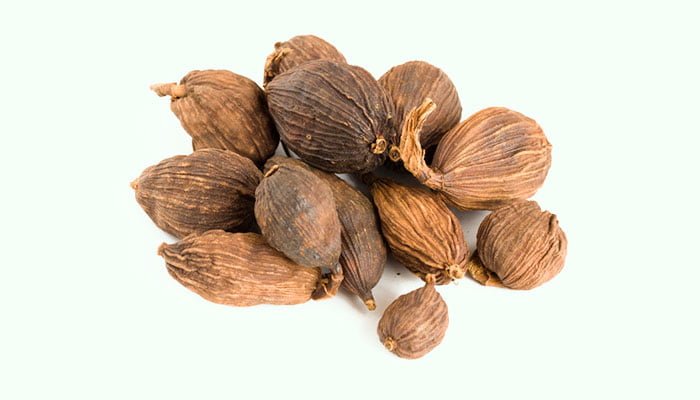What Is Cao Guo
Cao Guo commonly known as Fructus Tsaoko or Tsaoko Fruit is the ripe fruit of Amomum tsao-ko Crevost et Lemaire, which is a perennial herb belonging to the family Zingiberaceae. It is a common edible spice, which first appeared in <Yinshan Zhengyao> (Dietary Principles) in 1,330 AD.
Previously, Amomum tsao-ko Crevost et Lemaire belonged to the genus Amomum. It is now grouped into the genus Lanxangia.
There are about 8 species of Lanxangia, which are mainly distributed in China, Laos, Malaysia, Thailand, and Vietnam.
Amomum tsao-ko Crevost et Lemaire is also known as Lanxangia tsao-ko. They like warm and humid climates. They grow well in loose, fertile, sandy loam rich in humus. They often grow in sparse forests or shady, moist, well-drained valley slopes with an average annual temperature of 15-20 ℃ and an altitude of 1,000-2,000 meters. They are found in China, Laos, and Vietnam.

In autumn, people collect the fruits of Amomum tsao-ko, remove impurities, dry them in the sun or at low temperature, stir-fry them, remove their shells, or stir-fry them with ginger juice, and make them into Chinese herbal medicines.
Cao Guo contains a lot of volatile oil, and its components include α-thujene, α-pinene, β-pinene, camphene, sabinene, α-phellandrene, α-terpinene, γ-terpinene, terpinolene, p-cymene, 3-carene, β-myrcene, ocimene, 5-caranol, 1,8-cineole, fenchol, δ-terpineol, anethole, perillyl alcohol, bornanone, myrtanal, carveol, 4-thujanol, citronellol, linalool, nerol, geraniol, geranial, germacrene D, δ-cadinene, β-elemene, α-caryophyllene, copaene, α-cubebene, β-cubebene, elemol, eudesmol, farnesol, octanal, decanal, linoleic acid, decanoic acid, octanoic acid, n-octanol, 2-decenol, n-hexanol, and benzonaldehyde.
In addition, it contains o-cresol, hydroquinone, catechol, vanillic acid, protocatechuic acid, gentisic, protocatechualdehyde, carvacrol, eugenol, epicatechin, procyanidin B2, quercetin, rutin, hyperoside, tsaokonol A-J, tsaokone, isotsaokoin, tsaokoin, sitosterol, eleuthosides, polysaccharides, proteins, tannins, anthraquinones, cardiac glycosides, amino acids, and some trace elements.
Generally, reddish-brown and plump Cao Guo with a strong aroma are preferred.
According to <Mingyi Bie Lu>, the medicinal nature of Cao Guo is relatively warm, with a pungent taste. It has a certain therapeutic effect on the pathological changes of the spleen and stomach meridians.
In traditional Chinese medicine, it is often used to dry dampness and warm middle energizer, prevent malaria and eliminate phlegm, and treat abdominal distention and pain, nausea, vomiting, functional dyspepsia, chronic peptic ulcer, malaria, plague, influenza, alopecia areata, epilepsy, chronic renal failure, aplastic anemia, conjunctivitis, infantile autumn diarrhea, postoperative abdominal distension, and promote the recovery of gastrointestinal function after laparoscopic cholecystectomy.
Benefits
- Anti-inflammation, inhibiting LPS-induced NO and PGE2 production in RAW264.7 cells.
- Anti-oxidation, scavenging DPPH free radicals, increasing superoxide dismutase, catalase, glutathione peroxidase activities, and reducing malondialdehyde content.
- Increasing gastric mucosal blood flow and gastric juice secretion in rats, protecting gastric mucosa, and inhibiting the formation of gastric ulcers.
- Inhibiting the activity of α-glucosidase, reducing the fasting blood glucose level in type 2 diabetic model mice (modeled with a high-sugar and high-fat diet and streptozotocin), and improving the impaired glucose tolerance and insulin resistance of rats.
- Drying dampness and warming middle energizer, treating abdominal distention and pain, nausea, vomiting, diarrhea, greasy and foul fur caused by the excess of cold-dampness.
- Treating alternating spells of fever and chills caused by malaria, and plague fever.
- Inhibiting the proliferation of nasopharyngeal carcinoma 6-10B cells and H22 hormonal cells, and inducing apoptosis in HepG2 cells, Hela cells, SGC-7901 cells, and Bel-7402 cells.
- Its water extract can significantly improve loperamide-induced constipation in mice.
- Its volatile oil has a certain inhibitory effect on Staphylococcus aureus, Methicillin-resistant Staphylococcus aureus, Escherichia coli, Salmonella, Helicobacter pylori, Candida albicans, and yeast.
- Studies have found that its methanolic extract can inhibit fat absorption, promote fat oxidation, and reduce triglyceride content in mice [1].
Combinations
- It can be used in combination with Wu Zhu Yu (Evodiae Fructus), Gan Jiang (Dried Ginger), Sha Ren (Fructus Amomi), etc. to treat abdominal distention and pain, nausea, vomiting, diarrhea, greasy and foul fur caused by the excess of cold-dampness.
- It can be used in combination with Chang Shan (Radix Dichroae), Zhi Mu (Rhizoma Anemarrhenae), Bing Lang (Semen Arecae), etc. to treat alternating spells of fever and chills caused by malaria.
- It can be used in combination with Qing Hao (Sweet Wormwood), Huang Qin (Radix Scutellariae), Guan Zhong (Dryopteris), etc. to treat plague fever.
- It can be used in combination with Mu Xiang (Radix Aucklandiae), Xiao Hui Xiang (Fructus Foeniculi), Ding Xiang (Flos Caryophylli), etc. to treat abdominal distention and pain, hiccup, loss of appetite, fatigue, and gastroesophageal reflux.
- It can be used in combination with Rou Gui (Cinnamomi Cortex), Gan Cao (Licorice Root), Ba Jiao Hui Xiang (Anisi Stellati Fructus), Zi Qi Guan Zhong (Rhizoma Osmundae), etc. to treat epigastric pain and indigestion caused by qi stagnation due to congealing cold.
Side Effects
- At present, there is no literature report that Cao Guo has toxic effects, and no data is showing that taking it at the prescribed dose can cause serious adverse reactions.
Precautions and Warnings
- The dosage of Cao Guo should be controlled at 3-6g.
- It can be made into decoctions and pills.
- It is recommended to crush Cao Guo before using it.
- People who are allergic to Cao Guo should not take it.
- Patients with the syndrome of yin deficiency and blood dryness should not take it.
- Pregnant and breastfeeding women should take it under the guidance of a doctor.
